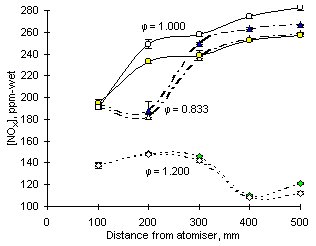A graph of concentrations of NOX measured at all equivalence ratios, selected sampling distances and sulphur addition is presented in Figure 150.
In fuel-lean conditions ( = 0.833) there was a small 2 ppm-wet decrease in the concentration of NO2 at short distances when SO2 was added. This is the result of opposed effects encountered by NO and NO2. Whilst nitric oxide is decreased by sulphur, nitrogen dioxide is increased. As the concentration of NO2 falls at longer distances the decreasing effect of S on NO prevails. The final outcome was a moderate decrease of total NOX of approximately 10 ppm-wet over a total 267 ppm-wet in absence of SO2.
= 0.833) there was a small 2 ppm-wet decrease in the concentration of NO2 at short distances when SO2 was added. This is the result of opposed effects encountered by NO and NO2. Whilst nitric oxide is decreased by sulphur, nitrogen dioxide is increased. As the concentration of NO2 falls at longer distances the decreasing effect of S on NO prevails. The final outcome was a moderate decrease of total NOX of approximately 10 ppm-wet over a total 267 ppm-wet in absence of SO2.

Figure 150: Experimental readings of NOX from fuel M1 at three equivalence ratios, S addition and selected sampling distances. Solid symbols: air; open symbols: addition of 2.0 % S
In stoichiometric conditions the final effect was similar, although it evolved at a later stage in the gas path. No net change in NOX concentration was seen in the first 200 mm of the sampling path. At 100 mm there is no change in the concentrations of NO and NO2 as an effect from SO2 addition. Thereafter, sulphur decreases nitric oxide whereas nitrogen dioxide is increased. As the concentration of NOX peaked and decreased at longer distances from the atomiser, both effects intensify. The result on NOX is dictated by the larger decrease of NO. A decrease of 9 ppm-wet was measured on exhaust.
Marked increases of total NOX concentrations were obtained in fuel-rich conditions, although not from the earliest stages investigated. Whereas a small decrease of 4 ppm-wet was registered at 100 mm from the atomiser, a pronounced increase was obtained subsequently, mainly as a result of the large increase of NO2 caused by the addition of sulphur dioxide.
Pollutant formation and interaction in the combustion of heavy liquid fuels
Luis Javier Molero de Blas, PhD thesis, University of London, 1998
© Luis Javier Molero de Blas
 = 0.833) there was a small 2 ppm-wet decrease in the concentration of NO2 at short distances when SO2 was added. This is the result of opposed effects encountered by NO and NO2. Whilst nitric oxide is decreased by sulphur, nitrogen dioxide is increased. As the concentration of NO2 falls at longer distances the decreasing effect of S on NO prevails. The final outcome was a moderate decrease of total NOX of approximately 10 ppm-wet over a total 267 ppm-wet in absence of SO2.
= 0.833) there was a small 2 ppm-wet decrease in the concentration of NO2 at short distances when SO2 was added. This is the result of opposed effects encountered by NO and NO2. Whilst nitric oxide is decreased by sulphur, nitrogen dioxide is increased. As the concentration of NO2 falls at longer distances the decreasing effect of S on NO prevails. The final outcome was a moderate decrease of total NOX of approximately 10 ppm-wet over a total 267 ppm-wet in absence of SO2.



